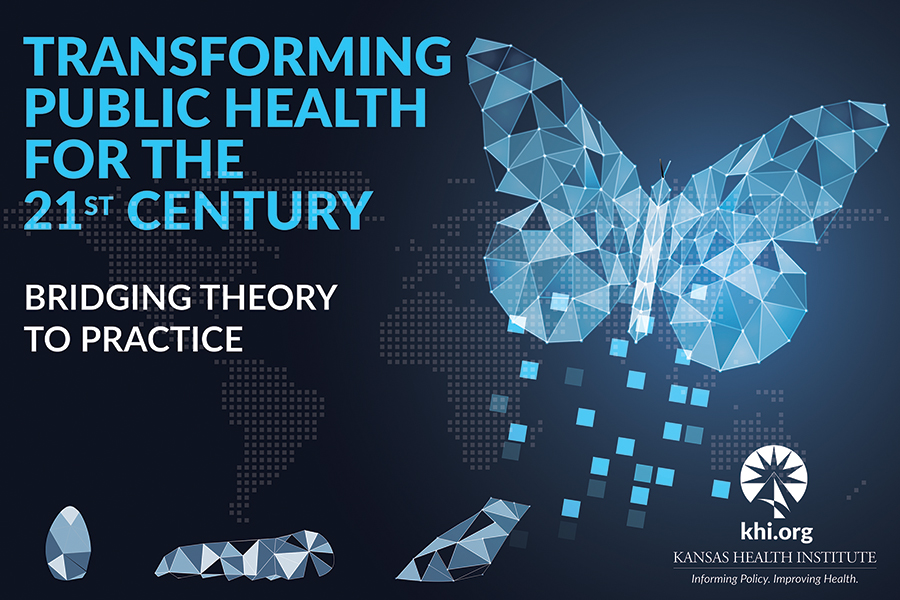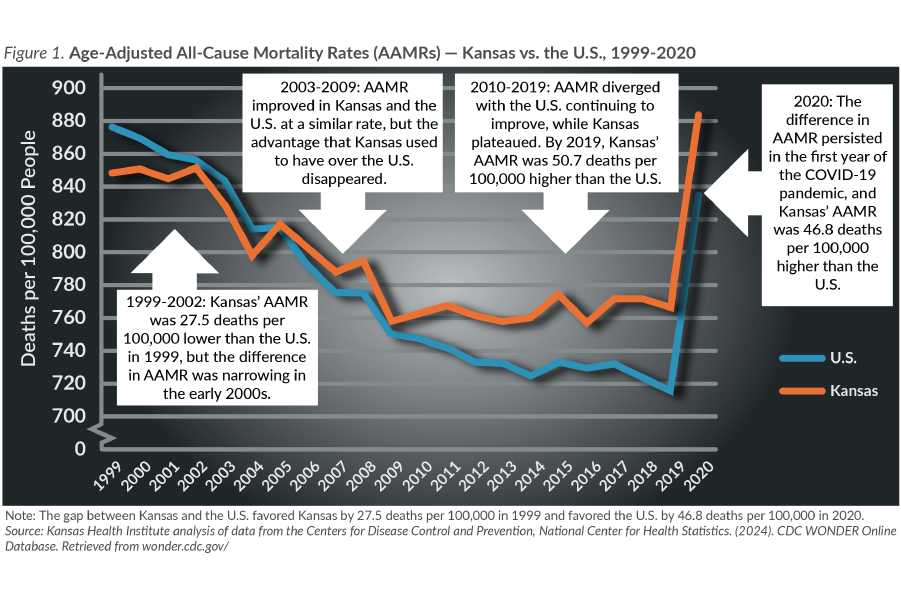What Happened to Health in Kansas? From Top 10 to the Bottom Half

Kansas was once one of the healthiest states in the nation. However, the past three decades have seen a significant decline in our state’s health status compared to the rest of the country. In 1991, Kansas was ranked as the eighth healthiest state in the nation by America’s Health Rankings. Fast forward to today, and our rank has slipped to 29th.
In 2019, the United Health Foundation stated that Kansas experienced the steepest decline in America’s Health Rankings among all states.
Moreover, the gap in age adjusted all-cause mortality rates between Kansas and the national average has shifted since 1999 (Figure 1). At that point, the age adjusted all-cause mortality rate in Kansas was 27.5 deaths per 100,000 fewer than the U.S. By 2020, however, Kansas’ rate exceeded the U.S. by 46.8 deaths per 100,000. This represents a widening of the gap by approximately 75 deaths per 100,000 people from 1999 to 2020. The increasing trend in this gap is remarkably consistent, suggesting that this isn’t an anomaly.

Data from the Centers for Disease Control and Prevention reveal that both Kansas and the U.S. experienced declines in age adjusted all-cause mortality rates from 1999 to 2019, with a notable spike in 2020 due to the pandemic. Kansas boasted lower age-adjusted all-cause mortality rates than the national average until 2005, signifying a healthier population. However, trends shifted as age adjusted all-cause mortality rates across the U.S. began to improve more sharply than in Kansas. This discrepancy became especially evident from 2009 to 2019, a period during which the U.S. saw continued improvements, but Kansas plateaued.
These trends signal an escalating health challenge in Kansas, posing a threat to the state’s overall well-being and its competitive standing with other states. Although it might seem contradictory, given that overall health status in Kansas has seen improvements, it’s critical to acknowledge that these gains aren’t as great as would have been expected.
Why Might Health in Kansas Be Losing Ground?
Before pinpointing specific health conditions or behaviors where Kansas falls short, it’s crucial to consider the broader context that shapes population and individual health. Health encompasses not only the absence of illness but also physical, mental and social well-being. It’s influenced by a complex interplay of factors, encapsulated in what public health experts call the socio-ecological framework (Figure 2). This idea can be visualized as a “stream of causation,” where upstream factors like policy, culture and societal values shape socioeconomic status, community conditions, individual behaviors and health outcomes.
To address these health challenges effectively, it’s essential to identify “upstream” leverage points within policies, environments and systems that can lead to widespread health improvements. Healthy policies have the power to transform living conditions, influencing what people are exposed to and how they behave. Public health science underscores the difficulty of changing behaviors without altering the surrounding community conditions, especially on a population level.

Strategic Opportunities for a Healthier Kansas
Edwards Deming, a pioneer in business process improvement, once observed that “every system is perfectly designed to get the results it gets.” This suggests that the current public health structure in Kansas might be aligned with the outcomes we are experiencing. Reversing this trend is likely to take more than the traditional focus on specific diseases, risky behaviors or access to care. Getting below the surface, to how health is viewed in Kansas and our paradigm about what shapes health, may be needed.
There are several statewide initiatives seeking to identify opportunities for a healthier Kansas. Healthy Kansans 2030 is a collaborative venture led by the Kansas Department of Health and Environment to identify and address leading health challenges in Kansas. The Kansas Health Foundation has launched a strategic framework that is aimed at helping Kansas lead the nation in health and eliminating the inequities that create health disparities. These are only a few of the initiatives that aim to reverse these trends and return Kansas back to its place as one of the healthiest states in the nation.
KHI also is actively engaged in efforts to deepen our understanding of the decline in our state’s health status compared to the rest of the country and to pinpoint effective leverage points for change. We will be launching a Delphi study to dig into the challenge. The study will involve experts, leaders and communities from across Kansas, who will “unpack” strategic issues that may be contributing to these trends and prioritize interventions based on their opportunities to leverage change. We consider this study a critical starting point for deconstructing the issue into more manageable elements, enabling more targeted and informed action. We hope that this information may help to inform an agenda for change and health improvement in Kansas.
Conclusion
Over the past two decades, health in Kansas has not kept pace with the U.S. Reversing this trend will require meaningful changes to the systems that shape the social and structural drivers of health. There are several statewide initiatives that aim to maximize health in Kansas and reverse these trends. It is essential that we identify more strategic opportunities for a healthier Kansas through dialogue, collaboration and innovative thinking. The journey toward a healthier Kansas will be challenging but is possible through collaboration and upstream action.
About Kansas Health Institute
The Kansas Health Institute supports effective policymaking through nonpartisan research, education and engagement. KHI believes evidence-based information, objective analysis and civil dialogue enable policy leaders to be champions for a healthier Kansas. Established in 1995 with a multiyear grant from the Kansas Health Foundation, KHI is a nonprofit, nonpartisan educational organization based in Topeka.